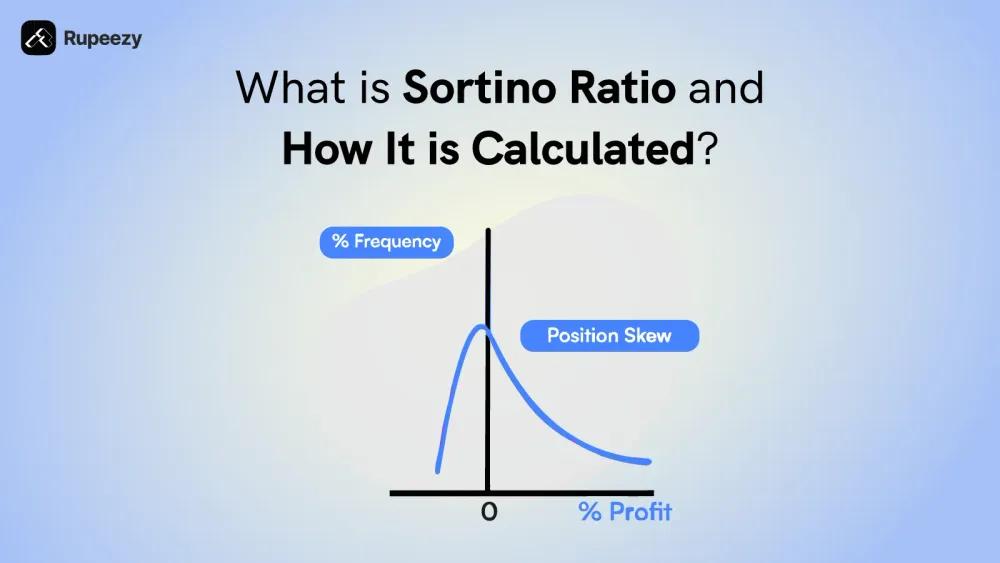Sortino Ratio in Mutual Fund - Meaning, Formula, Example


00:00 / 00:00
Did you ever think about how you can evaluate the quality of an investment apart from its returns? While profits often receive all of the attention, investors understand that the true picture lies in understanding the risks taken to achieve those returns. This is where the Sortino Ratio comes into play. A financial tool that focuses on downside risk, which helps investors make better and risk-aware decisions.
Unlike the other ratios, which include both upward and downward fluctuations in returns, the Sortino Ratio focuses only on downside risk, the kind of movement that investors worry about.
In this article, we will learn the Sortino Ratio meaning, its formula, how to calculate it, and what is a good number for it
What is Sortino Ratio in Mutual Funds
In mutual funds, the Sortino Ratio is a statistical tool that is used to measure the performance of an investment’s portfolio and helps investors determine the additional returns that they get for each unit of downward risk. Evaluating the downward risk assists investors in understanding the portfolio's risk-adjusted performance and the estimated return that can be generated for a given level of downside risk.
A higher ratio shows a stronger risk-adjusted return, whereas a negative ratio suggests that the portfolio isn’t generating as many returns as the downside risk taken.
How to Calculate Sortino Ratio
To calculate the Sortino Ratio, measure the portfolio’s excess return over the risk-free rate and divide it by the downside deviation, which reflects only negative volatility.
Sortino Ratio Formula
The Sortino Ratio formula is as follows:
= Rp - Rf / Sd
Where,
Rp = Actual or expected portfolio return
Rf = Risk-free rate
SD = Standard deviation of downside
Sortino Ratio Example
Let us illustrate the Sortino Ratio with an example: Suppose there are two investments: Portfolio X has an annual return of 15%, and Portfolio Y has an annual return of 16%. The risk-free rate is assumed to be 8%, and portfolios X and Y have downward deviations of 5% and 10%, respectively.
Applying the Sortino ratio formula to both portfolios:
Sortino Ratio for X = (15 - 8)/5 = 1.4
Sortino Ratio of Y = (16-8)/5 = 1.6
Portfolio Y may provide higher returns than Portfolio X, but if you are an investor who values downside risk more, Portfolio Y is the better option because its Sortino ratio is higher.
Importance of Sortino Ratio in Mutual Funds
Let us now understand the importance of the Sortino Ratio in the points given below:
Focuses on Downside risk
The Sortino Ratio evaluates the performance of an investment by focusing only on the risk of losses and not on any fluctuations above the target return. Unlike other measures of risk, which focus on the positive price swings as well, the Sortino Ratio only focuses on negative returns. This is important as most investors are more concerned with losses and not with gains.
Assessment of risks
The Sortino Ratio is a more accurate estimate of risk as it ignores positive market movements and only focuses on negative movements. This is very helpful when selecting long-term mutual funds like retirement or education mutual funds. You want a fund that performs well, but does not fall too much during difficult times, and the Sortino Ratio can help you see this very clearly.
Performance Evaluation
The Sortino ratio allows you to compare mutual funds that are safer for your capital and select a fund that aligns perfectly with your goals and your level of risk tolerance.
Benchmarking
If a mutual fund produces high returns but also incurs significant losses, the Sortino Ratio will be low and indicate that the risk may not be worthwhile. A fund that gives stable returns with fewer downsides will have a higher Sortino Ratio, which means a better risk-adjusted performance.
How to Use the Sortino Ratio to Pick Better Mutual Funds
The Sortino Ratio assists investors in determining how much return a mutual fund generates in comparison to the risk of negative returns, which is particularly important for those looking to avoid losses. Unlike the Sharpe Ratio, which takes both upside and downside volatility into account, the Sortino Ratio focuses only on downside risk, making this metric more useful for cautious investors.
To use the Sortino Ratio when choosing mutual funds:
1. Compare Sortino Ratios Among Funds
Look at funds within the same category (e.g., large-cap, mid-cap, hybrid) and compare their Sortino Ratios. A higher Sortino Ratio means that the fund is giving better returns per unit of downside risk, which generally indicates a stronger risk-adjusted performance.
2. Use a Proper Platform
Platforms like StockEdge provide ready access to Sortino Ratios for various types of mutual fund schemes. This data can be accessed by navigating to the Mutual Fund section on the website, selecting a category, and checking the “ratios” tab for each scheme.
3. Don’t Rely Solely on One Metric
While the Sortino Ratio is a powerful indicator, it's best used alongside other measures like past returns, the Sharpe Ratio, and fund holdings. This ensures that you're making a well-rounded decision that suits your investment goals and risk tolerance.
Sortino Ratio vs Sharpe Ratio
The following table compares the primary differences between the Sortino Ratio and the Sharpe Ratio:
Aspects | Sortino Ratio | Sharpe Ratio |
Meaning | It is a statistical tool used to evaluate an investment's portfolio performance and help investors calculate the additional returns generated for each unit of downside risk. | This financial measure helps determine the effectiveness of an investment or portfolio in managing risk and returns. |
Usage | It is used to assess investment portfolios that are very volatile. | It is used to analyze investment portfolios with minimal volatility. |
How is it calculated | The Sortino ratio formula is used to determine this. Rp - Rf / SD | The Sharpe ratio formula is used to compute this. Rx - Rf / SD |
Use cases | It is useful for evaluating investments that provide downside risk protection. | It provides valuable insight into the overall performance of an investment on a risk-adjusted basis. |
Significance | A risk-adjusted return on earnings is defined as a ratio of one or higher. | When the ratio is negative, it suggests that risk-free investments outperform on a risk-adjusted basis. |
Is a High Sortino Ratio Always Better?
A high Sortino ratio is typically seen as a positive indication, meaning that an investment produces larger rewards per unit of downside risk. This metric focuses solely on negative volatility, making it ideal for risk-averse investors. A Sortino ratio of more than 2.0 is considered extremely good, while more than 3.0 is remarkable.
However, a high Sortino ratio should not be considered in isolation. has limitations, such as ignoring upside volatility and not accounting for other risks like liquidity or credit risk. Furthermore, the ratio is based on past data, which may not accurately forecast future performance.
As a result, while a high Sortino ratio can be useful for assessing risk-adjusted returns, it should be used in conjunction with other metrics and qualitative factors to make well-informed investment decisions.
Conclusion
To sum up, the Sortino Ratio helps investors understand if a mutual fund is giving good returns without taking too much risk, especially the kind of risk that leads to losses. It focuses only on downside risk, which makes it more useful for careful investors who want to protect their money.
But remember, the Sortino Ratio is just one tool. It should not be used alone. To make smart investment choices, it's better to look at other factors too, like past performance, fund manager experience, and other ratios like the Sharpe Ratio.
In short, the Sortino Ratio is helpful, but using it along with other tools will give you a better and safer investment decision.
FAQs
Q1. What is a good sortino ratio for a mutual fund
A Sortino ratio of 2 or above is regarded as favorable for mutual funds since it delivers sufficient returns to offset the downside risk.
Q2. Is a higher sortino ratio better
Yes, the higher the Sortino ratio, the more efficiently the portfolio manages downside risk while delivering returns.
Q3. What if the Sortio ratio is negative
A negative Sortino ratio reflects poor risk-adjusted performance, where the losses outweigh any potential benefits.
Q4. Which is better Sharpe ratio or the Sortino ratio
While the Sharpe ratio includes total volatility in its calculation, the Sortino ratio isolates only the risk of negative returns. The Sharpe ratio is considered superior since it captures both upward and downward risk.
Check Out These Related Articles |
The content on this blog is for educational purposes only and should not be considered investment advice. While we strive for accuracy, some information may contain errors or delays in updates.
Mentions of stocks or investment products are solely for informational purposes and do not constitute recommendations. Investors should conduct their own research before making any decisions.
Investing in financial markets are subject to market risks, and past performance does not guarantee future results. It is advisable to consult a qualified financial professional, review official documents, and verify information independently before making investment decisions.

All Category









